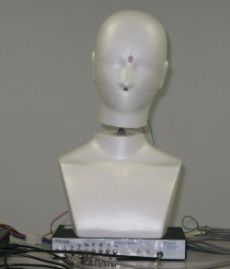Aug 31 2010
On 23rd August 2010, The University of Tokyo’s Institute of Industrial Science, declared that they have crafted an odor sensor that utilizes live insect cells, to identify some types of odorous matter. A robot is also built in with the sensor, and whenever the sensor identifies a certain odor, the robot twists its head. The institute’s researchers showcased the sensor, along with the robot to detect a smell.
Shoji Takeuchi, an associate professor at the Institute, stated that the sensor if embedded inside a nursing robot could detect some forms of mouth, or body smells, identifying air, water or food pollution, and even CO<sub>2</sub>. This sensor is developed by implanting the RNA (ribonucleic acid) from the living cells of insects, such as silk worm, into the oocyte or the egg cells of the Xenopus laevis, which is the African clawed frog. Then the membrane protein shows up, after several hours on the egg’s surface. This protein acts as a receptor in the case of odorous matter. To complete the odor sensor assembly, the egg is then fixed on an acrylic flow channel, measuring 3cm in length, 4cm in width with a depth of some millimeters, entrenched with electrodes.
 Odor sensor in robot
Odor sensor in robot
The membrane protein acts as a potent amplifier of some specific odorous matter. When a molecule of the odorous substance sticks to the receptor on the egg, the ion channels are exposed for some time, allowing the passage of many ions inside and outside the cell via the cell membrane. When an odorous substance, with a 100mV membrane potential, holds on to the receptor fixed on the membrane protein, the ion channel opens for a period of one second, and allows ions to the tune of 10 million, leading to the flow of a current, totaling up to quite a few Pico amperes (pA).
When the eggs are placed in the two edges of the odor sensor’s flow channel, the electrodes are immediately put in place inside the eggs. The membrane protein used, may be from the cells of cabbage moths or silkworm moths or vinegar flies and so on. If the membrane protein is taken from cabbage or silkworm moths, then it responds to pheromones, let loose by female moths, while the membrane protein from vinegar flies responds to a particular odorous matter.
The odor sensor has a characteristic property of being choosy, i.e. identifying only some odors. For instance the sensor can detect the difference between the pheromones of silkworm and cabbage moths even though the difference is very minute in the molecular chain structure. When the two types of eggs, namely BmOR1 and BmOR3 were set inside the flow channel, implanted with two varied membrane proteins, it was found that the odor sensor’s detection sensitivity’s standards, were many tens of ppb’s (parts per billion) i.e. equal to that of a sensor using oxide semiconductor. The life-period of the sensor is, at normal temperatures, around 12 hours, once the eggs are in the flow channel and the electrodes implanted. The ion channels will close once the substance is released even if the density of the odorous substance decreases after detection.
According to Takeuchi, the sensor could be used again and again, for a minimum of six tests, especially if it is chilled before use, and used like a disposable cartridge The eggs have a longer life before the sensor is attached to the flow channel. Sometimes instead of using membrane proteins that respond to pheromones, membrane proteins acquired from mosquitoes were implanted in the frog’s eggs, and sometimes even synthetic receptors are used. But human cells as receptors for tastes and odors do not work, as their protein alters its form, when confronted by an odorous matter.